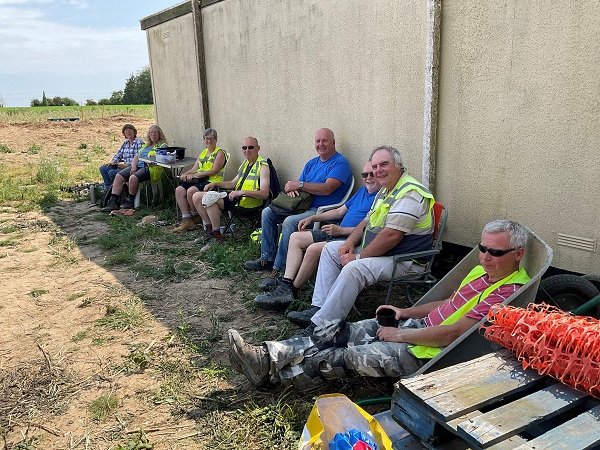Lees Court Estate: Interview with an archaeologist
The 2023 season is underway, so two of our novice members paid the site a visit, and this is what they learned.
The team relaxing in the shade at Lees Court Estate.
How do we know that this may be a burial mound?
The clues are gradually revealed by excavating the earth, trowel-full by trowel-full, around a ditch in a farmer’s field. Small test pits were dug and revealed the layers of earth, chalk, and flint laid down over generations.
Small items were found as these test pits gradually expanded, which we subsequently dated to the Neolithic age.
What does the site look like?
To the untrained eye, it looks like a field which, a few months ago had grass and bare earth, and now has several deep trenches dug! There are planks to assist walking over the trenches, and the ground is marked with little red flags and strings marking out the suspected outline of the burial area – which has been deduced from geophysics tests and photographs.
What have the trenches revealed?
Digging down the high-sided (and very neat) trenches enables the archaeologists to reveal the layers of earth, chalk and flint that act like a timeline showing the periods in antiquity, which are then marked with coded flags the deeper they dig. This gives them a reference point to date the items in the different layers.
In one corner of the field, several shards of flint were found scattered about a single point. Some shards could be pieced back together to form the original larger flint from which these were chipped. It is thought that this could be where an artisan arrowhead or flint tool maker may have sat to create their pieces and then discarded the leftover flint waste around where they sat.
What is it like to work on the dig?
The Dover Archaeological Society were in the field on the day of our visit. It was a hot and dry day, but at the beginning of the dig, they had to cope with high winds and cold temperatures. They remained a happy bunch, all suitably clad in outdoor clothes and sturdy walking boots with ankle supports, as the site has many holes, hummocks, tracks and divots. Their enthusiasm was evident, and as long as trowels, tea and plenty of Jaffa cakes were provided, they were making good progress and revealing many finds!
A mobile site office and a large tent were in place so that finds could be cleaned, catalogued, labelled and filed into crates and boxes. These will be returned to the Kent Archaeological Society HQ for further study. As well as the physical digging element, the administration, classification and recording of finds are essential.
What are the main finds on this dig?
Regarding artefacts, the main items being found daily on the dig are flint tools, pot and container shards and some animal bones.
Evidence has been found regarding site excavations for a burial mound and cremation site. The mound also appears to have holes created that would have taken large, ‘D’shaped poles to support a wooden structure. The trench around the mound was dug in sections, possibly by different ‘teams’, which don’t quite match up and join exactly.
What does this tell us about the history of the site?
Judging by the ring ditch and the mound, this burial site was likely considered significant to the local population who might have come here to worship or revere those buried there. In Neolithic times, the site would have been on a raised area, clear of vegetation and easily visible on the skyline.
Has this been a successful dig?
Yes! The landscape, particular to Kent, presents some challenges. Due to intensive farming over the years, the mounds are often flattened, whereas they might remain in other parts of the country. Piecing together the small fragments of pottery, bone, flint and stone will enable the archaeologists back at HQ to put together the evidence of the story of this place and time travel back to when the flint makers and tribes who lived here went about their daily lives.
How can I get involved in an archaeological dig?
If you would like to take part in the next Kent Archaeological Society dig, then please get in touch with us. There are many roles – from digging the dirt to washing and labelling the finds, metal detecting to site recording with drawings and photos, database recording to helping with geophysics. Our team of experts and experienced volunteers can guide you through what needs doing, and you’re sure of a warm welcome (and a good supply of tea and biscuits!)
Please get in touch using the contact us page.

